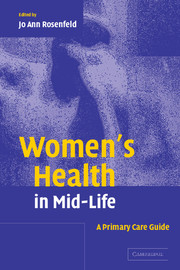Book contents
- Frontmatter
- Contents
- List of contributors
- 1 Introduction
- Part I Health promotion
- Part II Hormonal changes
- Part III Disease prevention
- Part IV Cancer prevention
- 16 Breast cancer: screening and prevention
- 17 Cervical cancer: prevention, screening, and early detection
- 18 Endometrial cancer: prevention, screening, and early detection
- 19 Ovarian cancer: prevention, screening, and early detection
- 20 Colon, lung, and skin cancer: screening and prevention
- 21 Common gastrointestinal and urinary problems
- Index
- References
17 - Cervical cancer: prevention, screening, and early detection
from Part IV - Cancer prevention
Published online by Cambridge University Press: 21 August 2009
- Frontmatter
- Contents
- List of contributors
- 1 Introduction
- Part I Health promotion
- Part II Hormonal changes
- Part III Disease prevention
- Part IV Cancer prevention
- 16 Breast cancer: screening and prevention
- 17 Cervical cancer: prevention, screening, and early detection
- 18 Endometrial cancer: prevention, screening, and early detection
- 19 Ovarian cancer: prevention, screening, and early detection
- 20 Colon, lung, and skin cancer: screening and prevention
- 21 Common gastrointestinal and urinary problems
- Index
- References
Summary
Case: S.T. is a 45-year-old mother of two grown-up daughters. She comes in, complaining of fatigue. She is sleeping well and physical examination is normal, except for a 18-week-size uterus. She has not had a Pap test for 15 years. She complains of heavy and frequent menstrual periods, but considers this normal. Laboratory tests show a hematocrit of 21, with hemoglobin of 7.3 g/dl. Pap test reveals cells consistent with carcinoma.
Incidence
The incidence of cervical cancer has decreased since the 1950s and stabilized in the 1980s in the USA. Approximately 13 000 women will develop cervical cancer yearly, and approximately 4500 will die from it. Because the incidence and mortality of cervical cancer have decreased by more than 40% since 1973 and the push for mass screenings, the Agency for Health Care Policy and Research (AHCPR) has given Pap tests an “A” recommendation, despite poor evidence for their efficacy. In many cases, cervical cancer can be prevented.
The rate of cervical cancer varies widely with race. The highest incidence in the USA is among Vietnamese women, but the highest death rate is in African-American women, being approximately 50% higher than that of Caucasian Americans. Death rates for cervical cancer increase with increasing age. Because stage I (invasive but localized) cancer has a 90% five-year survival rate, while stages III and IV (advanced invasive and/or metastatic) have a five-year survival rate of 12%, screening and early detection are possible, effective, and essential. Prevention may or may not be possible.
Keywords
- Type
- Chapter
- Information
- Women's Health in Mid-LifeA Primary Care Guide, pp. 287 - 292Publisher: Cambridge University PressPrint publication year: 2004



